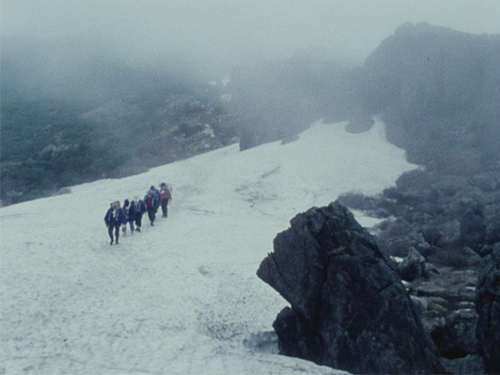
Iwate Prefecture, Ohasamacho. In the foothills of Mt. Hayachine, the kagura (devotional dance) offered to the mountain goddess by the mountain priests is still performed today nearly unchanged from mediaeval times. This dance, which has been handed down along several lines of succession in the villages of Take and Otsugunai, has its origins in prayer. Take’s kagura and Otsugunai’s kagura are said to be closely related. The film shows the people who lovingly continue to perform these two types of dance and the transition from ancient tradition to modern life. Even from the first moment that director Haneda was charmed by Hayachine’s kagura, the mountain villages that were home to the gods had already begun to disappear.
“In an Italian film similar to this one, L’albero degli zoccoli / The Tree of Wooden Clogs, director Ermanno Olmi told us, with rare insight, about the heart and the inner world of Italian peasants. Haneda goes here even further, for her, it is not only the heart of the people who speaks in her movie, but it is as the whole of nature, trees and stones, were speaking to us. Although we are in 1982, immersed in our contemporary problems, at the same time, we live with simplicity in an uncomplicated world that has just been created right now. There is a difference between Olmi and Haneda, and it may be a difference that exists between a country with a Catholic tradition and a country with a Shinto tradition, but still there is a miracle that is common to the two. This miracle is that in their clear mind everything is sublimated and yet, a direct and spontaneous force, an inspiration and a beauty in the detachment of modern daily life is gradually invading our hearts. For Haneda, the mountain gods, the plastic products in the small shops in the village, the people who dance the kagura, and the tourists are just as passionate and fantastic. Everything is just as important to her non-sentimental gaze. That is, past and future, nature and machinery, mountains and towns.
What is art for, what is fiction for, what position does the profilmic material occupy in a movie, what position does fiction occupy in art? What about the artist? What happens to the artists filmed? Rarely in the history of cinema have such essential questions been asked in such a direct, simple, generous, and intelligent way. I am a filmmaker, and until now I believed that I would be closer to the truth if I approached it through fiction, but now, after seeing Haneda’s Ode to Mt. Hayachine, I realize that the idea is an arrogant one, we must take advantage of this opportunity, we must learn to see reality correctly in order to know the truth.”
Paulo Rocha1
- 1Paulo Rocha on Ode to Mount Hayachine, Asian Docs.

